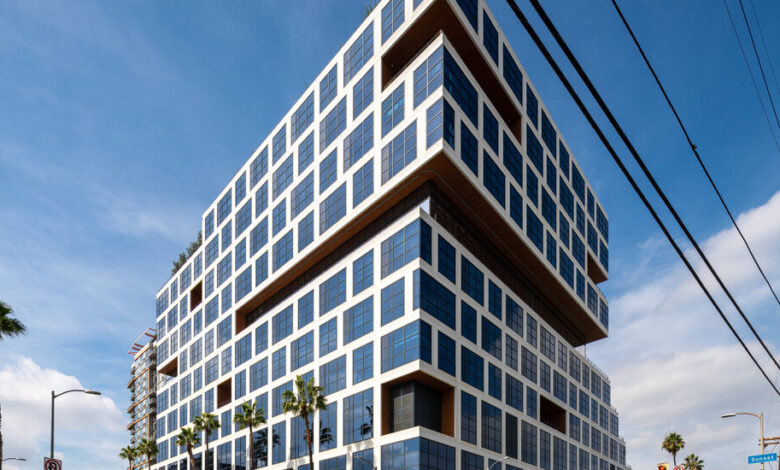As Risks of Climate Change Rise, Investors Seek Greener Buildings

[ad_1]
When the developer Lendlease opens its $600 million residential and office complex in Los Angeles, expected in 2025, the site will have the typical hallmarks of sustainable development: proximity to a light-rail stop, an all-electric residential tower, solar panels and a pedestrian plaza.
But those features are considered commonplace these days. What makes this development more striking is how sustainability isn’t simply an amenity or signifier of corporate responsibility, but a core feature of its financing plan.
“We were doing sustainable development before there was investor pressure, but now there is investor pressure,” said Sara Neff, head of sustainability for the Americas region at Lendlease.
The company’s investor partner for this project, Aware Super, will be tracking environmental performance and metrics, including eliminating tenant emissions by procuring 100 percent renewable energy.
The project is part of a larger movement of investors steering money toward sustainable real estate, thanks to new technology and tougher standards that allow for better tracking of a development’s ability to reduce its carbon footprint.
Other players in the sector include Hudson Pacific Properties, the owner of Epic, a solar-paneled office tower in Hollywood that is occupied by Netflix. And Prologis, the international industrial giant, sells green bonds that fund the construction of more sustainable warehouses.
Sustainable real estate isn’t a new idea. The Green Building Council has promoted more efficient development for nearly three decades through LEED, its standard for building sustainability.
What has changed in recent years is the perception of risk associated with climate change, prompting investors to steer money toward safer, higher-performing green assets. New measurement tools and standards are empowering them to raise the bar for environmental and economic performance.
“Carbon counting and the focus on carbon will define the decade ahead, without a doubt,” said Dan Winters, head of the Americas region for GRESB, a real estate sustainability benchmark used to analyze $5.3 trillion in assets globally.
Increasingly dire reports of more frequent natural disasters — like the flooding and harsh winds of Hurricane Ida, which caused an estimated $27 billion to $40 billion in property damage in late August and early September, according to the data firm CoreLogic — have hammered home the realization that climate change is affecting real estate much sooner than expected. Eighty-eight percent of large companies have already had a physical asset, such as an office or warehouse, affected by extreme weather, according to Cervest, an A.I. platform that monitors corporate climate risk.
On Oct. 15, President Biden, who has made various climate proposals central to his Build Back Better agenda, released a strategy to seek more financial disclosures from publicly traded companies on climate risk in an effort to help steer investors toward more resilient assets.
Lendlease’s Los Angeles project is part of a string of new mixed-use developments that the developer is building in North America, including 1 Java Street in Brooklyn. The company is betting that sustainable development means attracting better tenants and getting ahead of regulations to create a more valuable asset, which draws more investors.
“You need to have development excellence, but it also has to translate into operational excellence,” Ms. Neff said. “Those factors, plus the overall carbon picture, tend to be the metrics that investors are looking at.”
Developers are seeing an increasing hunger for investing that focuses on three areas — environmental, social and governance — a trend that is channeling significant capital.
Mutual funds and exchange-traded funds invested nearly $300 billion in sustainable assets globally in 2020, nearly double the previous year, according to BlackRock, the world’s largest asset manager. In April, Invesco started an exchange-traded fund for green buildings, and a similar green real estate fund started by Foresight last year has shown double-digit returns.
“Five to 10 years ago, there was a lot of debate about sustainability, that, ‘It’s nice, but I don’t want to pay for it,’” said Stephen Tross, chief investment officer of international investments at Bouwinvest, a Dutch investment firm managing roughly $17 billion in assets with significant North American interests. “Today, you don’t sacrifice returns for sustainability, you create returns with sustainability.”
The emergence of new regulations — New York passed a law in 2019 requiring building owners to reduce their carbon footprint and Massachusetts recently passed a similar law — adds to the risk of not investing in new sustainable development.
Real estate has a significant footprint when it comes to emissions and climate change, said Brendan Wallace, a managing partner at Fifth Wall, a tech-focused real estate investment fund. He added that building operations in the United States accounted for roughly 40 percent of all energy consumption.
“The real estate industry has been, to some extent, the culprit that has been hiding in plain sight,” Mr. Wallace said. “And now it’s starting to occupy a place in the spotlight.”
The effects of climate change are altering the strategies of big financial players like the Mortgage Bankers Association that are calling for more transparency in investment standards. Initially, much of the focus on sustainability came from investors with long-term views, including the California Public Employees’ Retirement System, the New York Common Fund and the central bank of Norway, which helped create the GRESB standard.
The alphabet soup of standards — like LEED and GRESB — can be confusing, and many see the lack of common guidelines and technology as an issue, fueling a widespread belief that the market pull of more disclosure can be a more effective means of cutting carbon than heavy-handed regulations alone.
“The S.E.C. and others are just saying, ‘Disclose your risk,’ and investors will decide what they want to do,” said John Mandyck, chief executive of the Urban Green Council in New York.
Critics see many issues with sustainable investment, including so-called greenwashing, in which companies present a misleading image of environmental responsibility. Doing good also doesn’t always improve the bottom line.
But the process of selecting E.S.G. investments doesn’t just screen out bad assets, it also helps investors gravitate toward better ones, a Harvard study found. More sustainable buildings attract higher-quality tenants and allow for higher rents, up to 10 percent more, according to a study of London office space by JLL.
More accurate tools and data make it increasingly easier for asset managers and investors to compare properties, portfolios and performance. For instance, Measurabl, a climate tech system, measures energy and resource performance across 10 billion square feet of assets.
“If I have better E.S.G. data, I can attract more capital, at a better cost of capital,” said Greg Smithies, a partner at Fifth Wall and leader of its climate technology investment team.
The most important use of this technology is likely to be in evaluating and retrofitting existing buildings. Fund managers will need to understand which ones can be updated to meet new standards and regulations and which ones are likely to become stranded assets, an increasingly tricky calculation as building technology matures.
Older buildings that don’t lower their carbon footprint are likely to suffer a “brown haircut” and depreciate in value in as soon as five years, said Oliver Light, commercial director for Carbon Intelligence, a London firm advising firms that manage $111 billion in assets. Not investing with sustainability in mind now means higher costs in the long run.
“Our largest clients will no longer buy an asset until our team of engineers has done a due diligence report on that acquisition,” Mr. Light said. “They’ll know what they need to spend on an asset in 10 to 15 years, and if it’s too much, say a glass skyscraper that’ll never hit the right performance metrics, then why buy such a risky asset?”
[ad_2]
Source link






